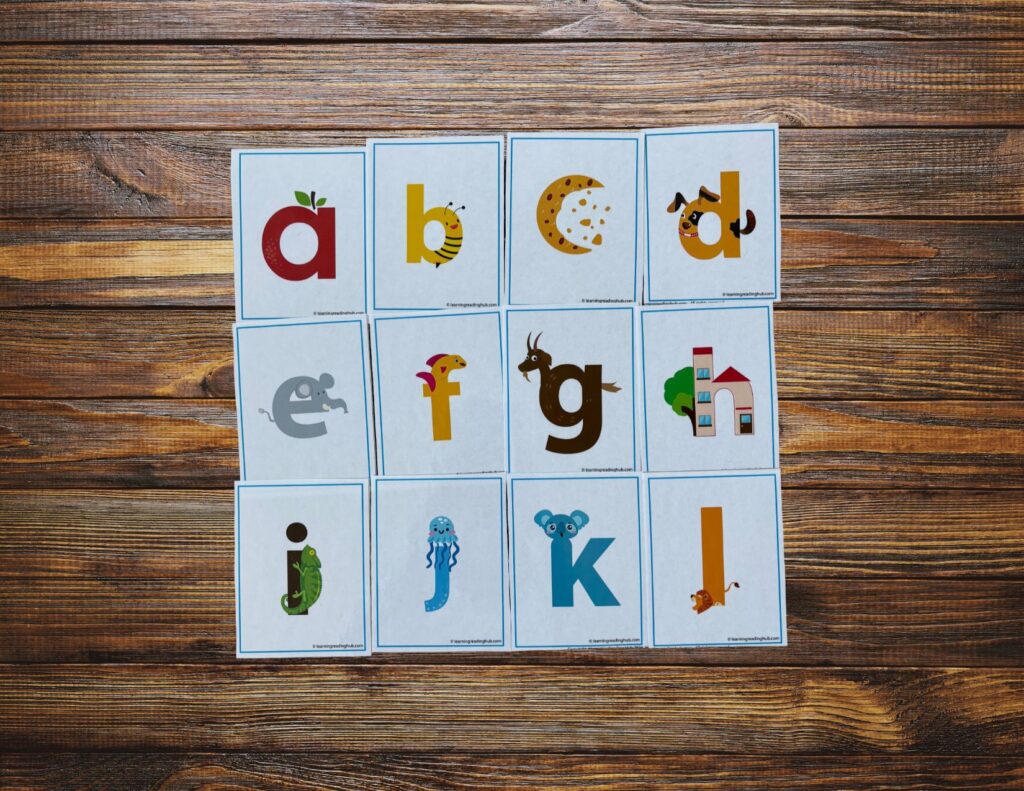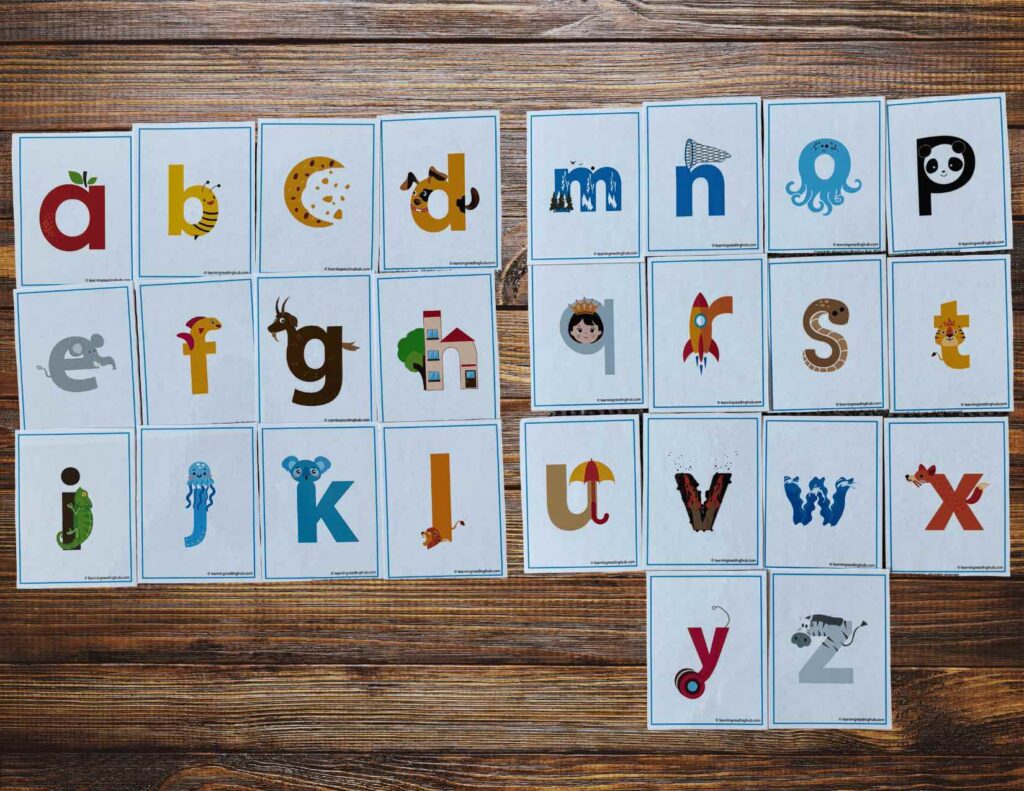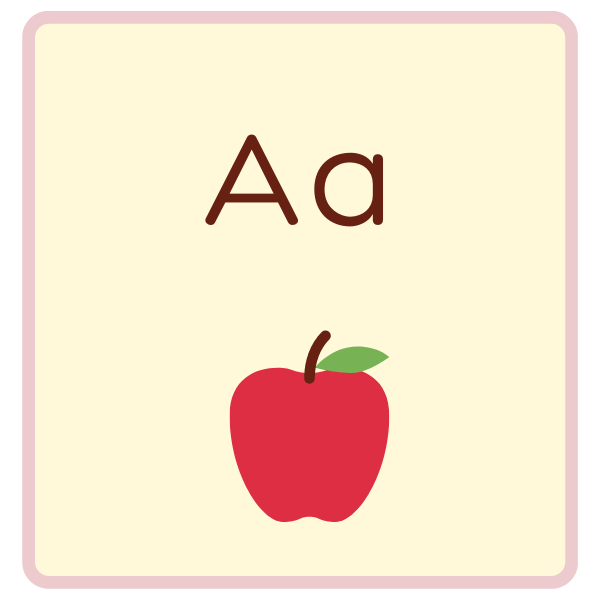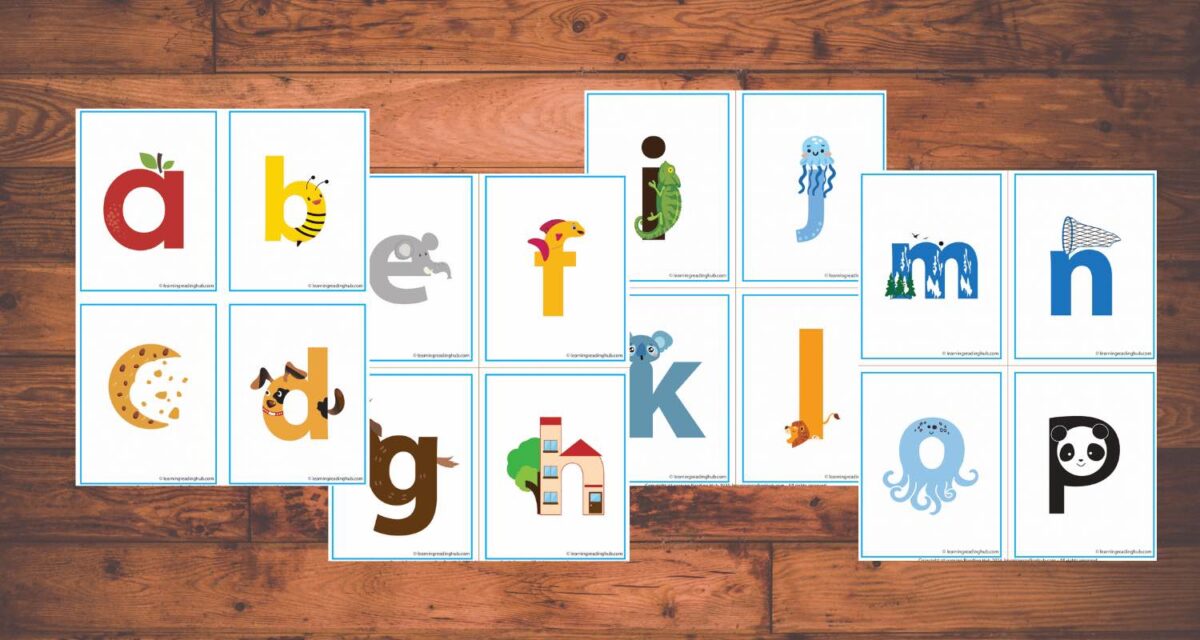Are you struggling to teach your child the alphabet, feeling like progress is at a snail’s pace? Are those familiar squiggly shapes proving elusive for your little one to remember?
Let’s talk about a powerful tool (embedded picture mnemonics) to help you exactly with that: teach your child letter sounds, and making them stick for good in your child’s memory!
What is embedded mnemonics?
Embedded mnemonics is an effective (and research-based!*) tool to help children learn the alphabet.
The very first stumbling block for many kids when learning to read is actually learning the alphabet: letters and sounds.
How can embedded picture mnemonics help?
Embedded mnemonic flashcards have a picture embedded in it that resembles of the actual letter shape.
For instance, in the example below, taken from our PhonixPals Mnemonic Flashcards:
- The letter the letter “a”has the shape of an “a, a, apple.”
- The letter“b” has the shape of a “b, b, bee.”
- The letter “c” has the shape of a “c, c, cookie.
- The letter“d” has the shape of a “d, d, dog.”
- The letter“e” has the shape of an “e, e, elephant.”
- The letter“f” has the shape of a “f, f, fish.”

How does embedded mnemonics help children learning to read memorize letters and letter sounds?
It has a lot to do with meaningful learning. Suddenly all of those random letter shapes start to make a lot sense.
Why does the letter “c” have that shape? Because there’s a cookie hiding in it. Why does the letter “d” have that shape? Because “d” has the shape of a dog!
This gives logic and meaning to the alphabet.
I’ve experienced first-hand how that has really helped my kid link letter form to its sound.
Meaningful learning allows children link new content to previous personal experiences, not only making it long-lasting, but also motivating, as learners find a practical sense in what they have learned and see their progress.
“Meaningful learning allows new information to be integrated in a logical and relevant manner into the learner’s knowledge base, thereby promoting deep and enduring comprehension where linguistic knowledge is fixed in the mind without the need for mechanical memorization. The student gathers new information and, thereafter, selects, organizes, and relates it to other knowledge and experiences they already possess, which act as an anchor point for new concepts.
This is a learning process with unique characteristics. Its constructive nature, allowing the student to relate the content to previous personal experiences, makes it long-lasting. […] The motivation of the learners greatly is greatly increased when they find a practical sense in what they have learned and see their progress.”
Extracts from the paper: “Facilitating the language to stick in the mind”, by Dr Eva Diaz Garcia.
Research specifically on using mnemonic flashcards found that using these mnemonic pictures help kids learn letter and sounds with fewer repetitions. Not only that, it reduces confusion and improves long-term memory!
“Embedded letters were mastered in fewer trials, were less frequently confused with other letters, were remembered better 1 week later, and facilitated performance in word reading and spelling transfer tasks compared to control letters. We suggest that embedded mnemonics better secured letters to their sounds in memory which in turn improved word learning for children in Ehri’s (2005) partial alphabetic phase.”
“Embedded Picture Mnemonics to Learn Letters”, by Adina Schmidman & Linnea Ehri https://www.tandfonline.com/doi/abs/10.1080/10888430903117492
“Integrated pictures were effective because they linked 2 otherwise unconnected items in memory. It is concluded that the shape of letters included in pictures reminded learners of previously seen pictures with those shapes whose names began with the relevant letter sounds.”
“Pictorial mnemonic for phonics,” by Ehri, L. C., Deffner, N. D., & Wilce, L. S.”Journal of Educational Psychology, 76(5), 880–893 https://psycnet.apa.org/record/1985-09174-001
PhonixPals Mnemonic Flashcards
There are lots of sets of mnemonic flashcards out there, and that’s a good thing. However, not all of them have been created equally!
I actually started using one set I bought online, and that’s what put me on the right path. It was effective and worked for some letters, but unfortunately not for all.
Why?
Because some of the keywords simply weren’t intuitive enough for my child! For instance, with the letter “i” (sound /i/), the keyword they used was “insect,” but my daughter would say “bug,” causing confusion, and probably making her link the letter “i” with the /b/ sound.
So, I decided to create my own version of mnemonic flashcards.
My main goal when creating my version of embedded picture mnemonic flashcards was for them to be EXTREMELY INTUITIVE. They had to trigger the first word that intuitively came to my kid’s mind when she saw the embedded picture.
This was my top priority, as my child had issues specifically with that, as explained before.
Apart from being highly-intuitive, these are the other factors I took into consideration when creating my own version of mnemonic alphabet cards:
- Cute and Colorful: Designed with colorful and cute illustrations because we know children love engaging visuals! We want them to like these cards!
- Contain Familiar Themes for Children: Keywords are chosen from children’s everyday world (like animals, food, toys, etc.) to resonate with their life and vocabulary. For instance, dog, bee, elephant, fish, iguana, jellyfish, yo-yo, etc. (For the entire list see the “keywords selected”)
- Clear and Free From Confusion: I avoided using words that will cause any type of confusion, including sound confusion, such as words starting with consonant blends*
- Fun and Engaging: So your child enjoys the learning process. This not only fosters a wonderful bonding experience between you and your child, but also helps engage their attention. Increased focus and attention will lead to better learning outcomes.
- Affordable: I am excited to offer this resource at a reasonable price, making it accessible to more families and educators.

PhonixPals Mnemonic Flashcards – Available at the “Discover Our Literacy Materials” section for only $7.99!
* Avoiding confusion is key – including sound confusion!
This is why I decided to avoid using words that begin with consonant blends (such us “gl”, for “glass”,“gr”, for “grass”,”bl” for “black” or “br” for “brick”).
Why? The sounds in blends tend to be said very quickly, so it can be difficult for children to isolate the two sounds that form the blend.
Another example of a bad word choice would be the word “ant” for the letter “a.” While there isn’t a consonant blend here, there’s a tendency to glue the sound of the letter “a” to the next one, which ends up in distortion of this sound in many speakers. Listen closely: “ant”, this is not a very clear /a/ sound.
KEYWORDS SELECTED:
a, apple
b, bee
c, cookie
d, dog
e, elephant
f, fish
g, goat
h, house
i, iguana
j, jelly fish
k, koala
l, lion
m, mountain
n, net
o, octopus
p, panda
q, queen
r, rocket
s, snake
t, tiger
u, umbrella
v, volcano
w, wave
x, fox
y, yo-yo
z, zebra

Why is it so difficult for children to learn letter sounds?
Some kids seem to breeze through it, but for many others, learning the alphabet (letter names and letter sounds) is very hard.
If you are going through this with your child, you may find consolation in knowing this is very common!
It may look like a really simple task to you. It’s only 26 letters, only 26 sounds to get started…
But, no… For children, it’s really hard!
There are several reasons that explain why exactly that is the case:
– Information gets stored only in your child’s short-term memory. If it looks like your child has learned a letter sound, but then you go back to it again (maybe later in the day or the next day) and he/she has forgotten all about it, this is the exact reason why this happens. We need those letters in your child’s long-term memory for immediate retrieval (it has to be like an instinct – I see this letter, I say this sound).
– The connection between letter shapes and sounds is completely arbitrary. In other words, the shapes of letters themselves don’t inherently indicate their sounds. There’s no logic or meaning attached to it. That’s the actual problem that embedded mnemonics comes to solve!
–The need of constant repetition. Some children might just need more repetitions. Again, embedded mnemonics is a tool that helps us in needing less number of repetitions.
How are embedded picture mnemonic flashcards different from alphabet cards with a visual cue?
Please, DO NOT confuse embedded mnemonics with the traditional flashcards that have a letter and a picture underneath or on top (as the one shown in the picture below).

Even if they are everywhere, these -unfortunately- do not help children.
About a dozen studies have shown they don’t really help kids learn sound-letter relationships.
In fact, in my opinion, they can even be detrimental, as many kids learn to “cheat” when using these flashcards, giving us the false impression that they’ve learned the sounds, when they haven’t.

PhonixPals Mnemonic Flashcards – Available at the “Discover Our Literacy Materials” section for only $7.99!
Customers Say…
Love them!
Summary
Super cute. My kid loves them, and have noticed great improvement since using them. Thanks!
They work!
Summary
These flashcards have helped my son so much! I’m surprised mnemonics aren’t talked about more. For us, they’ve been a life-saver!
Amazing!
Summary
Super cute, and very effective. They really helped my kid learn the letters!

Hey there! I’m Laura – an author, YouTuber, blogger, and the creator of the “Learning Reading Hub” platform. I created this space to dive into the world of reading instruction and to shout from the rooftops about how vital it is to use the right methods for teaching reading. I’ve got a TEYL certification (Teaching English to Young Learners), plus a Journalism degree from the University of Navarra in Spain, along with a Master’s Degree in Communication.
I’ve always loved digging into research, jotting down my thoughts, connecting with people, and sharing what makes me tick. With a background in marketing, digital projects, and the education scene (especially language learning), I’m all about wearing different hats.
When my first kid needed to learn how to read, it opened my eyes to the challenges and complexities involved. This journey took me through a rollercoaster of self-teaching, eye-opening discoveries, and yeah, some letdowns too. There’s so much conflicting info out there, along with methods that just don’t cut it. And let’s face it, these issues are way too common.
Now, I’m all about channeling that passion (without sounding like a know-it-all!) and sharing my journey. My mission? Making it easier for those who are on the same path I once was.
My heart’s with my family and the amazing Learning Reading Hub project. I live with my husband and two little ones, raising them in a bi-lingual environment (English and Spanish).

